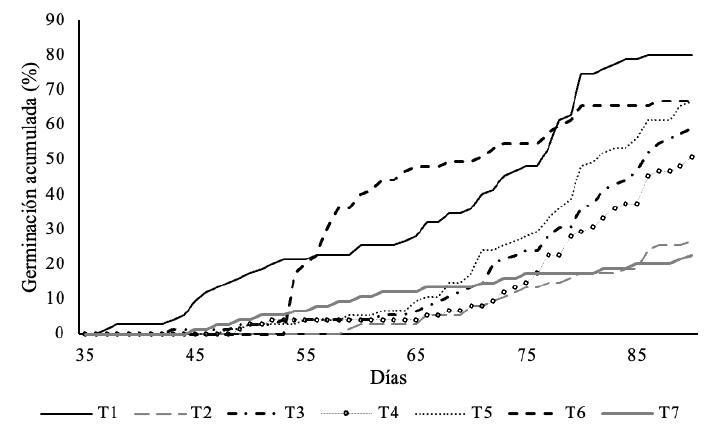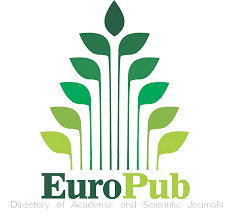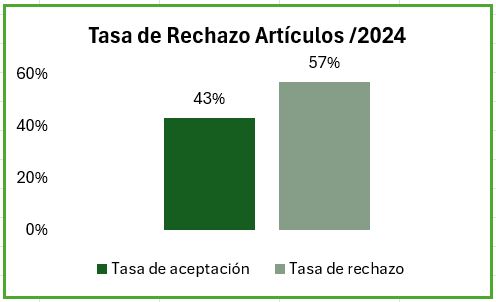Evaluation of pre-germination treatments in Juglans neotropica Diels seeds. in the north of Ecuador.
DOI:
https://doi.org/10.54753/blc.v13i1.1737Keywords:
Propagation, endocarp, dormancy, germination, seedlingsAbstract
The species Juglans neotropica Diels, known in Ecuador as nogal or tocte, is threatened due to the loss of its habitat in the Andean region of South America. In the country there is little knowledge regarding the correlation between the decrease of the walnut population and the mastery of techniques for the propagation of the species. The reproduction of J. neotropica is limited by the physical dormancy of its seeds; pre-germination treatments are an ideal means to overcome the low uniformity in the germination of walnut seeds due to their lethargy. The present investigation had the objective of evaluating the effect of pre-germination treatments on the dormancy of Juglans neotropica seeds. A completely randomized experimental design was used with six treatments and one control, three repetitions and 25 seeds for each experimental unit. Regarding the accumulated germination, at the end of the test, all the pre-germination treatments presented significantly higher percentages than those registered by the control. Among the treatments used, running water for five days (T1) showed greater germination capacity, according to all the variables linked to this criterion, reaching a final germination percentage of 80%; while the scarification of the seed tip with a No. 80 sandpaper for ten minutes reached its germination peak (66%) in less time. It is concluded that the pre-germination treatments significantly influence the increase in the percentage and decrease in the germination time of Juglans neotropica.References
Añazco, M. (2021). Programa de investigación Juglans. Universidad Técnica del Norte. Ibarra, Ecuador.
Aponte, R. V., y Sanmartin, J. C. (2011). Fenología y ensayos de germinación de diez especies forestales nativas, con potencial productivo maderable y no maderable del bosque protector el bosque de la parroquia San Pedro de Vilcabamba, Loja. [Tesis Ingenieria. Universidad Nacional de Loja], Loja, Ecuador.
Barbin, D. (2003). Planejamento e análise estatística de experimentos agronômicos. Cárdenas, D., & Salinas, N. (2006). Libro rojo de plantas de Colombia, Especies maderables amenazadas I parte. Bogotá, Colombia: SINCHI-MAVDT.
Fenner, M., & Thompson, K. (2005). The ecology of seeds. Cambridge University Press. Gómez, M. L., & Toro, J. L. (2007). Manejo de las semillas y la propagación de diez especies forestales del bosque. Medellín, Colombia: Corporación Autónoma Regional del Centro de Antioquia- CORANTIOQUIA.
González-Zertuche, L., & Orozco-Segovia, A. (1996). Métodos de análisis de datos en la germinación de semillas, un ejemplo: Manfreda brachystachya. Botanical Sciences, 58, 15–30.
López Carvajal, J., E. Piedrahíta Cardona. (1998). Respuesta de la semilla de cedro negro (Juglans neotropica Diels) a la aplicación de tratamientos pregerminativos. Rev. Fac. Nal. Agr. Medellin, 51(1), 217-235.
Ministerio del Ambiente del Ecuador. (2012). Sistema de clasificación de los ecosistemas del Ecuador continental. Subsecretaría de Patrimonio Natural. Quito.
Nieto, V. M., & Rodríguez, J. (2002). Juglans neotropica Diels. Tropical tree seed manual, 528–529.
Ospina Penagos, C. M., Hernández Restrepo, R. J., Aristizabal Valencia, F. A., Patiño Castaño, J. N., & Salazar Castaño, J. W. (2003). Título: El cedro negro: una especie promisoria en la zona cafetera.
Palomeque, F. J. (2012). Natural succession and tree plantation as alternatives for restoring abandoned lands in the Andes of Southern Ecuador: Aspects of facilitation and competition. (Tesis Doctoral). Technische Universität München, Munchen, Alemania.
Peña, D., Rocano, M., Salazar, J. y Torres, C. (2014). Inducción de la brotación in vitro de microplántulas de Nogal (Juglans neotropica) tratadas con Thidiazuron (TDZ) y 6-Bencilaminnopurina (BAP). MASKANA, 5(2).
Restrepo, M. L. G. (2004). Estimación de la capacidad germinativa y el vigor de las semillas de diomate (astronium graveolens jacq.) sometidas a diferentes tratamientos y condiciones de almacenamiento. Revista Facultad Nacional de Agronomía Medellín, 57(1), 2215–2227.
Roach, D. A., & Wulff, R. D. (1987). Maternal effects in plants. Annual review of ecology and systematics, 209–235.
Rocano, M., Villena, P., & Peña, D. (2017). Evaluación de los sistemas de cultivo semisólido y BIT en la multiplicación in vitro de Juglans neotrópica. MASKANA, 8(1), 103-109.
Stone, D. E., Oh, S.-H., Tripp, E. A., Ríos G, L. E., & Manos, P. S. (2009). Natural History, Distribution, Phylogenetic Relationships, and Conservation of Central American Black Walnuts (Juglans sect. Rhysocaryon). The Journal of the Torrey Botanical Society, 136(1), 1–25. http://www.jstor.org/stable/40207615
Toro Vanegas, E., & Roldán Rojas, I. C. (2018). State of the art, propagation and conservation of Juglans neotropica Diels., in Andean zones. Madera y bosques, 24(1).

Published
Versions
- 2023-01-18 (2)
- 2023-01-15 (1)
How to Cite
Issue
Section
License
Copyright (c) 2023 Bosques Latitud Cero

This work is licensed under a Creative Commons Attribution-NonCommercial-ShareAlike 4.0 International License.
This work is published under the Creative Commons Attribution-NonCommercial-ShareAlike 4.0 International (CC BY-NC-SA 4.0) license. This means that users may copy, distribute, and adapt the content, provided that proper credit is given to the authors and the journal. Commercial use of the material is not permitted. Additionally, any derivative work must be distributed under the same license. This license ensures open access to knowledge, promoting the dissemination and reuse of published works for non-commercial purposes, respecting authorship, and ensuring the free circulation of content under fair terms.




























